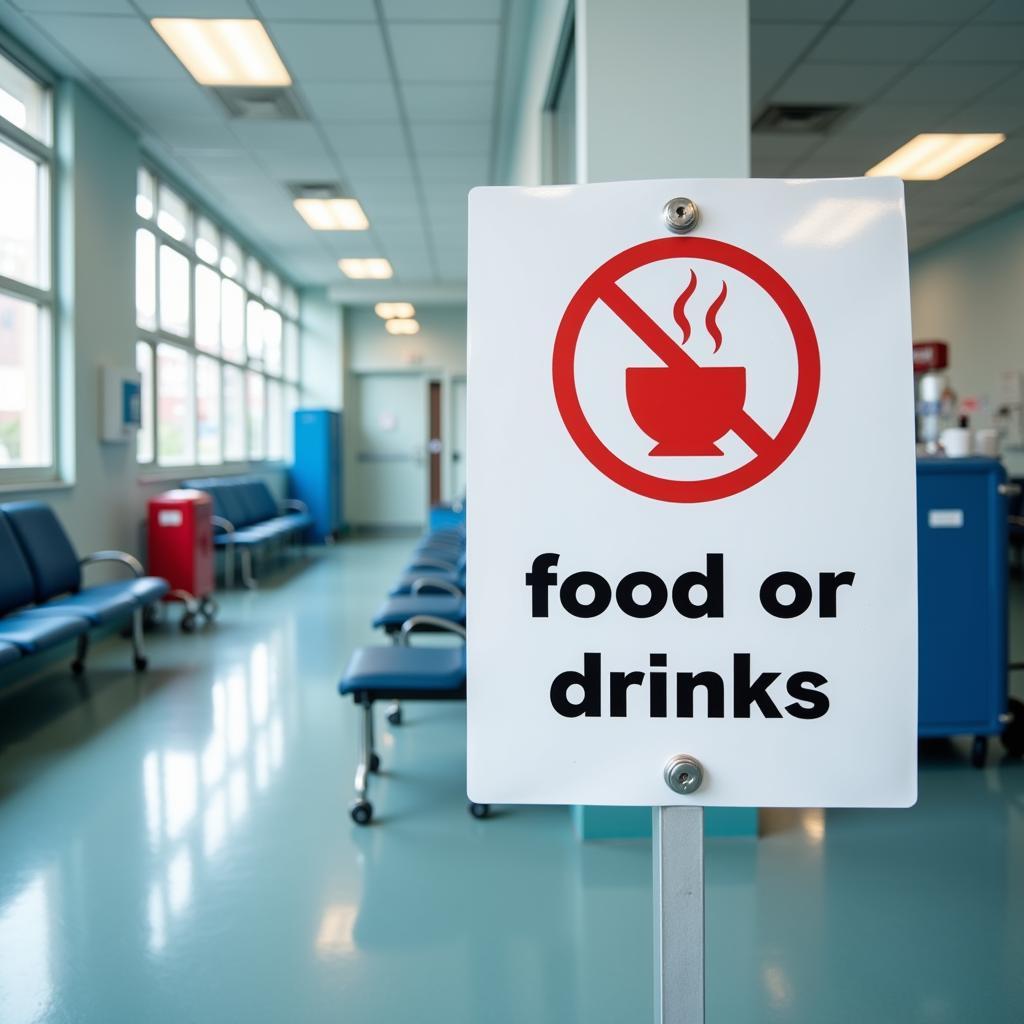The “No Food Or Drinks Sign” is a ubiquitous symbol, a silent sentinel guarding countless spaces from crumbs, spills, and sticky messes. But have you ever stopped to ponder its nuances? When is this sign a gentle suggestion and when is it a hard-and-fast rule?
Let’s delve into the world of this unassuming sign and explore the reasons behind its existence.
Reasons Behind the Rule: Why “No Food or Drinks Allowed”?
While a simple sign might seem self-explanatory, there are often multiple reasons why establishments enforce this rule. Understanding these motivations can shed light on the importance of respecting the “no food or drinks sign.”
1. Preserving Hygiene and Cleanliness
 No food or drinks sign in a hospital waiting area
No food or drinks sign in a hospital waiting area
Let’s face it, food and drinks can be messy. Spills happen, crumbs scatter, and sticky residues linger. In environments where hygiene is paramount, like hospitals or laboratories, these seemingly insignificant remnants can harbor bacteria and compromise sanitation protocols.
Imagine a world where a dropped ice cream cone in a doctor’s office could potentially impact patient health. This is precisely why the “no food or drinks sign” acts as a crucial line of defense, protecting the integrity of these sensitive spaces.
2. Protecting Valuable Assets
Think about libraries, museums, or art galleries – spaces filled with irreplaceable artifacts, delicate documents, and priceless masterpieces. Now, picture a rogue coffee spill on a centuries-old manuscript or a stray crumb attracting pests to a delicate sculpture.
These scenarios highlight the very real dangers that food and drinks can pose to valuable assets. The “no food or drinks sign” acts as a preventative measure, safeguarding these treasures for generations to come.
3. Maintaining Aesthetics and Preventing Damage
Have you ever noticed how a stray coffee stain can mar the pristine white of a tablecloth or how greasy fingerprints can dull the shine of a polished surface? In settings where aesthetics are a priority, such as high-end retail stores or art galleries, the “no food or drinks sign” helps maintain the visual appeal of the environment.
Furthermore, certain materials, like delicate fabrics or antique furniture, can be easily stained or damaged by spills. By prohibiting food and drinks, businesses can prevent costly repairs and preserve the longevity of their furnishings.
4. Ensuring a Safe and Enjoyable Experience for All
Picture this: you’re at a concert, completely engrossed in the music, when suddenly, a wayward elbow sends a drink flying, drenching you and ruining your experience. Or imagine attending a play only to be distracted by the constant crunching of chips from a fellow audience member.
The “no food or drinks sign” can play a vital role in ensuring a safe and enjoyable experience for everyone. By minimizing distractions and potential hazards, it allows everyone to fully engage with the event or activity at hand.
When Rules Bend: Exceptions to the “No Food or Drinks” Policy
While respecting the “no food or drinks sign” is generally good practice, there are instances where exceptions might apply. These exceptions often depend on the context, the specific establishment, and the nature of the food and drink in question.
- Designated Eating Areas: Many establishments that prohibit food and drinks in certain areas often provide designated spaces for consumption. Think museum cafes, theater lobbies, or hospital cafeterias.
- Medical Necessity: Individuals with medical conditions requiring regular food or drink intake are usually exempt from these restrictions.
- Special Events: Certain events, like catered gatherings or private functions, might supersede the usual “no food or drinks” policy.
Remember, it’s always best to err on the side of caution. If you’re unsure about the rules, don’t hesitate to ask a staff member for clarification.
Navigating the “No Food or Drinks” Landscape: Tips for Respectful Consumption
Now that we’ve dissected the reasoning behind the sign, here are some practical tips for respectfully navigating spaces where food and drinks might be restricted:
- Be Observant: Pay attention to signage and look for designated eating areas.
- Dispose of Trash Properly: If you are allowed to consume food or drinks, dispose of any trash responsibly.
- Be Considerate of Others: Avoid bringing in strong-smelling foods or making excessive noise while eating.
- Ask for Permission: When in doubt, it’s always best to ask a staff member for guidance.
The next time you encounter a “no food or drinks sign,” remember it’s not just a random rule, but a symbol representing a network of reasons aimed at creating a safer, cleaner, and more enjoyable experience for everyone.
FAQ: Your “No Food or Drinks Sign” Questions Answered
Q: Can I bring water into a museum?
A: While policies vary, it’s always best to check with the specific museum. Some might allow sealed water bottles, while others might have water fountains available.
Q: I have a medical condition that requires me to eat regularly. Can I bring food into a theater?
A: Most theaters are accommodating to medical needs. It’s best to contact the venue in advance and inform them of your requirements.
Q: What should I do if I accidentally spill a drink in a restricted area?
A: Alert a staff member immediately so they can address the spill promptly and prevent any potential damage.
For more insights on navigating the world of food and events, check out these articles:
Need help planning your next food-centric adventure? Contact Mina Cones Food today!
Phone: 02437655121
Email: minacones@gmail.com
Address: 3PGH+8R9, ĐT70A, thôn Trung, Bắc Từ Liêm, Hà Nội, Việt Nam
We have a dedicated customer support team available 24/7.